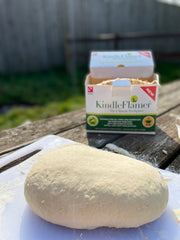
Cooking on Wood: Wild Garlic & Cheddar Tearing Bread
Share
Wild garlic season is well and truly here, so why not take this opportunity to venture outside and see what Mother Nature has to offer? This springtime is forecasted to be the optimal time of year for foraging, with fully-bloomed plants seen all across the UK woodlands. Wild garlic is an unmistakable scent in UK woodlands and forests with its fresh, garlicky, and pungent smell. In this blog, we will be exploring how to identify wild garlic when out on your spring walks, where you can spot wild garlic, how to responsibly forge it, and discuss its many versatile and flavourful uses.
Where can you find Wild Garlic?
Otherwise known as ramson, wild garlic is widespread across the UK. Wild garlic favours growth in damp woodlands, and you will often discover them in dense clusters, like the picture below. Did you know that wild garlic is an ancient- woodland indicator plant? If you spot a cluster when you're off on your spring walks, it could be a sign you're standing on a rare and old habitat. [1]


How do you Identify Wild Garlic?
Wild garlic is one of the easier plants to identify; not only will its strong scent give it away, but the plants' unique leaves and placement also make it apparent when out foraging.
Here's what to look out for:
- Strong garlicky aroma
- Long pointed leaves, with rounded edges
- Flowers are small & white with six petals.
- Bulbs are small & white
- Often found in clusters


Five steps on how to forage responsibility:
- Make sure you can positively identify any plant before you pick it. Some plants may be harmful and toxic to humans
- Similar to the previous point, do not consume any plant if you are unsure of its species
- In certain areas, make sure you seek permission before gathering. Some plant species may be protected, so it is always good practice to check with the landowner first
- Only pick from areas with food abundance. Never completely strip any plant species as it will have a detrimental effect on the surrounding ecosystems
- Never pick protected species and ensure you follow the Wildlife and Countryside Act (1981). [2]

How can you use Wild Garlic?
Wild garlic is one of the most versatile plants there is. The leaves can be used in soups, bread, pesto and eaten raw in salads and even the flowers are edible!
We recently ventured on our own little cooking endeavor, making a Wild Garlic and Cheddar Tearing Bread cooked outdoors on a wood fire.

Here's what you'll need:
- 500g flour
- 1 3/4 tsp salt
- 1tsp sugar
- 14g dried yeast
- 150 ml lukewarm water
- 150ml milk
- a bunch of wild garlic (some for making pesto and some for a side salad with your bread)
- strong cheddar
Step One:
In a small bowl, mix up a teaspoon of sugar and dried yeast, then add enough lukewarm water to cover. This is good practice in order to check that your yeast is live and fresh. Alternatively, you can add it straight into a well of mixed flour and salt.
You will know the yeast is activated once it's frothed up like pictured below.

Step Two:
After this, pour 150ml milk, 150ml of lukewarm water water and 4 tablespoons of oil into a jug and give it a quick stir.
Step Three:
Next, add your flour and salt into a large mixing bowl, then make a well in the middle. Pour in the frothed yeast and the milk-water-oil mixture into this well and then roll up your sleeves and start mixing the ingredients together in the bowl. It will initially be very sloppy but continue mixing with your hands until combined.


Step Four:
Once combined, tip the dough onto a floured surface. Continue kneading and adding more flour until a solid dough ball has formed which is smooth and elastic under the hand, about 10 minutes. Poor a tablespoon of oil into the bowl and grease it up, then pop your dough into it and leave it covered with a damp tea towel in a warm room or in the sun for approximately an hour to rise (it should double in size in this time).


Step Five:
Whilst the dough is rising, you can start preparing your pesto. Finely chop your wild garlic as per the photo below, transfer into a small dish and add two tablespoons of olive oil. Mix this and take a moment to appreciate the strong garlicky smell. Put away in the fridge until needed later.




Step Six:
Once the bread has risen, you will need to light your fire pit to give the wood time to burn through to get wood coals to cook your bread in.
What we used:
For this, we used our Flaming Firewood logs and one of our new KindleFlamers. We recommend using our Flaming Firewood when cooking on your firepit as they come in different cuts and sizes, normally smaller than our standard kiln dried logs, allowing you to manage and maintain the heat output with ease. Larger logs will take longer to burn through, but in this case you want smaller wood that will give you wood coal quickly which you will need to cook your bread in.
How we lit our Firepit:
We used the top-down method when starting our fire. Simply place 2 logs on the bottom of the firepit and lay your KindleFlamer between them. Place a couple of smaller logs on top of the KindleFlamer but make sure to leave gaps for air circulation. Light the KindleFlamer and Hey Presto!... the perfect fire.
Once your fire is going, add four to five more logs onto it. As advised above, choose smaller logs which will burn through quicker in order to get enough coals on which you can place your dutch oven. If your logs are still fully burning, they will give out too much heat and hence burn your bread as opposed to cooking in.

Step Seven:
Once you've got your fire going, which should take no time if using the recommended logs and KindleFlamers, it's now time to return to your nicely risen dough. Tip it onto onto a flat surface which doesn't need much flour. Split this dough into 3 identical smaller balls (you can weigh this if you want, but just a rough split will do). Don't knead for too long, just shape into three balls.


Step Eight:
With each of your dough balls, roll it into a long sausage-like shape. You can do this by rolling each ball between your hands or laying onto a flat surface and rolling (you might prefer the first option if space is an issue, especially if doing this outdoors). Once you have all three dough balls in a shape of a sausage, you can start to plait inside the Dutch oven which you need to line with baking parchment first (you don't want your bread sticking to the Dutch oven). You can also plat outside the Dutch oven on baking parchment and then transfer it, but this might be quite tricky, so we recommend doing this step straight in the Dutch oven.
If you struggle with this step, you can also shape your dough into 15 small balls and place them into the Dutch oven tightly together. It will achieve the same tearing effect once cooked.



Step Nine:
It's now time to take your pesto out of the fridge. With a pastry brush, spread all that garlicky goodness onto your proven dough. Put as much as you want on there, but we found that more is better. Sprinkle cheese over the top, again, as much or as little as you like, but we are cheese lovers so we were quite generous with our "sprinkling".


Step Ten:
Make sure the wood has burnt through so that you have no larger pieces left burning. Spread the hot wood coals in your firepit safely use a long-handled tool like a shovel or poker to create a space for your Dutch oven. You want a thin layer of coals on the bottom of the firepit onto which you place your Dutch oven. Then scoop up some wood coals with a shovel and place carefully on the Dutch oven lid. Leave cooking for approximately half an hour.


Step Twelve:
With a poker, lift up the lid of the Dutch oven. The bread should now look golden in colour. Safely remove your Dutch oven from your firepit whilst wearing well insulated oven gloves. Carefully take out the bread and place it onto a wooden board.
Step Thirteen:
This bread is best eaten warm so make sure you and your friends tuck in as soon as it's out of the oven. Serve with some side salad of wild garlic as well as the wild garlic pesto for dipping.
If wanting to add some wine to it, our office wine connoisseur, Alex, recommends going light and simple for your wine choice. If you fancy a red, a vibrant and cheeky Barbera with its ripe cherry youthful fruit and a touch of earth would work a treat. For a white, a delicate Gavi with May blossom aromas and light pear, peach and lemon flavors would make a great thirst-quenching option and also has a herby tinge to complement the pesto.


References:
[1] - https://www.countryfile.com/how-to/food-recipes/wild-garlic-guide-where-to-find-how-to-cook-it-and-recipe-ideas/
[2] -https://www.woodlandtrust.org.uk/trees-woods-and-wildlife/plants/wild-flowers/wild-garlic/
